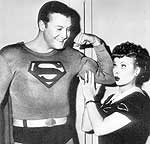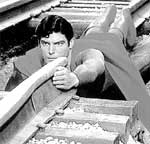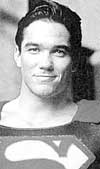|
Superman
through the ages
By Robert K. Elder
KRT Campus
Page Design by KRT Campus
Modified by Erin LaMourie/FEATURES EDITOR
Superheroes
may not get old, but they do change. Even Superman.
Every generation reinvents Superman to fit its own sensibilities,
as evidenced by the WB’s incarnation of the character in “Smallville.”
Set in present-day Kansas, the hit show centers on a teen-age Clark
Kent, whose powers are just beginning to surface.
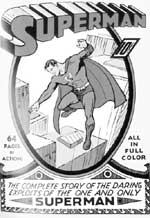 1939 1939 |
|
|
The
awkward, boyish Clark (played by the hunky and brooding Tom Welling)
doesn’t wear a costume, and episodes tackle modern issues such
as environmental pollution and eating disorders — all over
a soundtrack of today’s pop hits.
“One
of the things that enables a myth like this to live on is that periodically,
the people telling the myth dress it for the times,” said Paul
Levitz, publisher of DC Comics.
Below,
we look at significant milestones in this American icon’s life
story.
’30s
and ’40s
June
1938
Superman debuts in Action Comics No. 1, with the 13-page story of
his origin. Created by Jerry Siegel and Joe Shuster, the original
Man of Steel did not fly, but “could leap tall buildings in
a single bound.” Although he was more powerful than a locomotive,
“nothing less than a bursting shell could penetrate his skin”
— implying that he could be hurt.
Summer
1939
Superman No. 1: Superman gets his own comic book, as well as a newspaper
strip in 1939. His present-day reputation as a cosmic Boy Scout
isn’t quite in place yet.
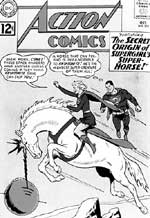 1939 1939 |
|
|
“He’s
perfectly content to let villains plummet to their death without
stepping in to save them,” said Mark Waid, author of the seminal
“Kingdom Come” comic-book series of 1996. After World
War II, Superman’s respect for all life becomes more pronounced
and he adopts the creed of using non-lethal force to protect humanity.
1940
On Feb. 12, 1940, “The Adventures of Superman” debuts
on the radio. Sharing a close relationship with the comic books,
the radio show invents Kryptonite and introduces new characters
such as kid photographer Jimmy Olsen, who soon gets his own comic
book.
’50s
and ’60s
1951
|
|
|
TV
Superman George Reeves with Lucille Ball
|
Following successful Superman film serials starring Kirk Alyn in
1948, George Reeves steps into the tights for the full-length feature
“Superman vs. the Mole Men” in 1951. The movie rakes in
money and serves as an unofficial pilot for “The Adventures
of Superman,” which runs on television from 1952 to 1957. Reeves
also stars as Superman in several movies, and even appears in costume
on “I Love Lucy.”
1957
In the late ’50s, veteran DC Comics editor Mort Weisinger handed
down “a mandate among writers to add a new element to the mythology
every six months or so,” Waid said.
Throughout
the ’60s, Superman acquires numerous superpals, among them
Supergirl, Krypto the Super-dog, Streaky the Super-cat and Comet
the Super-horse. Aliens and mad scientists show up in the comics,
reflecting the nation’s love affair with science fiction.
May
1963
Superman No. 161 features a story called “The Last Days of
Ma and Pa Kent” in which the Kents die of a space virus just
before Clark goes to college. But as anyone in the industry will
tell you, nobody dies forever in comics.
November
1963
In Action Comics No. 309, President John F. Kennedy “steps
in to masquerade as Clark Kent, to cover Superman’s secret
identity,” Waid said. Superman says, “If you can’t
trust the president of the United States, who can you trust?”
“That
issue was printed days before the assassination and was distributed
that week to the horror of DC Comics, who then couldn’t do
anything about it,” Waid said.
1966
Director Harold Prince brings the musical comedy “It’s
a Bird, It’s a Plane, It’s Superman!” to Broadway,
with songs by “Bye Bye Birdie” scribes Charles Strouse
and Lee Adams. It’s Broadway Kryptonite.
’70s
and ’80s
1971
DC editor Julius Schwartz takes over the Superman comics and gives
the superhero his first major revamp. Clark Kent quits the Daily
Planet and becomes a newscaster.
“Throughout
the late ’40s and early ’50s, Clark had become sort of
a Casper Milquetoast character in the comics. ... He was allowed
to lighten up a little bit. Act a little more normal and not be
such a caricature,” said veteran “Superman” writer
Roger Stern.
Kryptonite
is also done away with, and Superman’s powers are scaled back
because, in the words of writer Dennis O’Neil, it’s hard
to write stories about a guy who can destroy galaxies “by listening
too hard.”
1978
|
|
|
Christopher
Reeve in the hit 1978 movie
|
Based on a script by “Godfather” scribe Mario Puzo, director
Richard Donner brings “Superman: The Movie” to the silver
screen, starring Gene Hackman, Marlon Brando and newcomer Christopher
Reeve. It’s a smash hit, and three sequels follow.
1985
DC Comics attempts to streamline its character gallery, killing
off hundreds of superheroes from alternate worlds. Supergirl is
among the casualties.
1986
Writer/artist John Byrne and company revitalize the Superman mythology
from the ground up with the “Man of Steel” comics, fundamentally
changing the way the character is portrayed. From this point on,
Clark Kent is the character and Superman is the disguise. “The
‘man’ is more important than the ‘super,’”
Byrne said.
Byrne
brings Ma and Pa Kent back in his 1986 revision and subsequent creators
keep the Kents alive.
’90s
December
1992
Villain Doomsday pummels Superman into super-pulp as he tries to
save Metropolis. Superman dies in the ensuing battle. Issues of
“The Death of Superman” fly off the stands, but “no
one stays dead in comics for very long,” Byrne said.
|
|
|
Dean
Cain of “Lois and Clark”
|
1993
After a year of impostor Supermen, “a combination of Kryptonian
technology and Earthly spiritual beliefs” brings Superman back
to life, said DC Comics editor Mike Carlin.
1993-1997
Debuting the week the caped crusader comes back from the grave,
“Lois and Clark: The New Adventures of Superman” stars
Dean Cain as Superman opposite Teri Hatcher’s feisty Lois Lane.
December
1996
After a long engagement, Superman gets married to Lois Lane —
the first major change in continuity since 1986.
“His
relationship with Lois is as important as an alien invasion, and
he’s constantly being pulled in two directions,” writer
Loeb said.
1998
On Superman’s 60th birthday, he becomes the first superhero
to be honored with his own U.S. postage stamp.
2001
|
|
|
Tom Welling of “Smallville.” |
The TV show “Smallville” makes its debut late in the year.
Executive producer Al Goph remembers his hesitation about taking
on Superman: “There’s a part of you that goes, ‘It’s
the Holy Grail of superheroes. Are we even gonna touch this?’
Then we went back and read the history of Superman,” Goph said.
“I think the comforting thing for us was that he has changed
over the decades. We’re respectful without being slavish to
the canon.”
Current
Superman comics
Like
Tony Soprano, today’s Superman sees a superhero shrink. He’s
also changed the yellow in his costume to black, his way of remembering
the lives lost in a recent interplanetary war. Oh, and villain Lex
Luthor is now president of the United States.
Body
type
When
Superman first appeared, he was built like strongmen of the era,
adopting a Jack LaLanne-body type until the 1960s, said DC Comics
editor Mike Carlin.
But
ever since the rise of Arnold Schwarzenegger, Carlin said, society
has a different body ideal. Today’s Superman is a more bulky,
pumped-up character.
“I
do think that he’s become more chiseled, and more hyperbolically
representative of what a human looks like,” Carlin said.
The
super suit
“In
the old days his suit was made from the blankets he came to Earth
in, so it was also indestructible,” Carlin said. “What
we say now is his body emits a protective aura that keeps him invulnerable.
This is why he has to wear a skintight suit.” But even Superman
is vulnerable to magic and supernatural beings such as vampires
and werewolves.
Flying
“It
was really an invention of the radio, and even then they weren’t
very specific. Superman would go, ‘Up, up and away!’ and
there’d be a roar of wind,” said Superman writer Mark
Waid. “It took awhile before they decided he was actually flying.”
|




 1939
1939 1939
1939